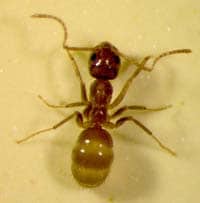The Tawny crazy ant (Nylanderia fulva) appeared in Houston, Texas in 2002. They spread to the Corpus Christi area. Tawny Crazy ants eat insects, small animals, and plant material. Organic material such as over-ripe fruit will attract these ants away from their outdoor nests and into homes.
The Tawny crazy ant appeared in Houston, Texas in 2002. They spread quickly to the Corpus Christi area. Tawny Crazy ants eat insects, small animals, and plant material. As an example, over-ripe fruit and “honeydew” from insects will attract them into homes.
Tawny Crazy Ants can be a major frustration for residents and livestock owners. For example, Tawny Crazy Ants attack the facial cavities and hooves of animals. In addition, they also cause damage to electrical equipment. In comparison, Red Fire Ants are far less frustrating.
Characteristics:
Tawny Crazy Ants have a red-brown color. However, they can be lighter or darker. Common worker ants are all about 1/8 inch long. Ants with a sexual purpose in life are much larger. Coarse hairs cover their bodies. They have no stinger. Instead, they have a small circular pattern at the tip of the abdomen.
These ants crawl erratically and rapidly. They often follow foraging trails. However, they will also make their own trails. This species nests under debris and landscape objects rather than digging underground nests.
Millions of Tawny Crazy Ants create a “super-colony.” Their movements are erratic and rapid. They nest under debris and landscaping rather than typical ant “hills.” Warm temperatures increase colony growth. In urban areas, colonies spread at a rate of 20-30 meters per month. Rural areas produce 200 meter/month growth.
Treatment Options:
Accurate treatment estimates need an evaluation of the colony structure and infestation area. Conventional control methods create temporary “buffer zones”. However, this is not effective for the Tawny Crazy Ant. Homeowners should remove debris and other objects to provide optimal treatment access.
They can be identified by sending samples to a Texas A&M University Urban Pest Center. Males with wings are needed for identification. You can visit Texas A&M University Extension services on the web. In addiction, you can contact your local extension agent to find more information.
(Click to see video of these ants found in the grass.)
Call US at (361) 980-7378 in Corpus Christi for premium treatment options.
-

Crazy Ant. Copyright by TAMU Tawny Crazy Ant. Photo from https://urbanentomology.tamu.edu/urban-pests/ants/rasberry/